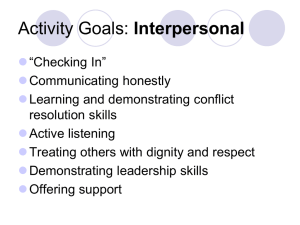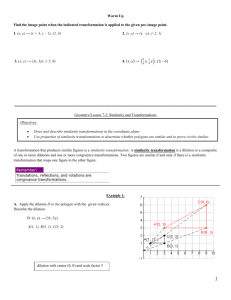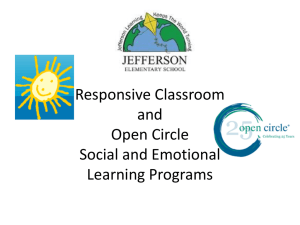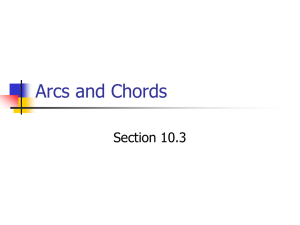8.2 Similarity and Transformations
advertisement
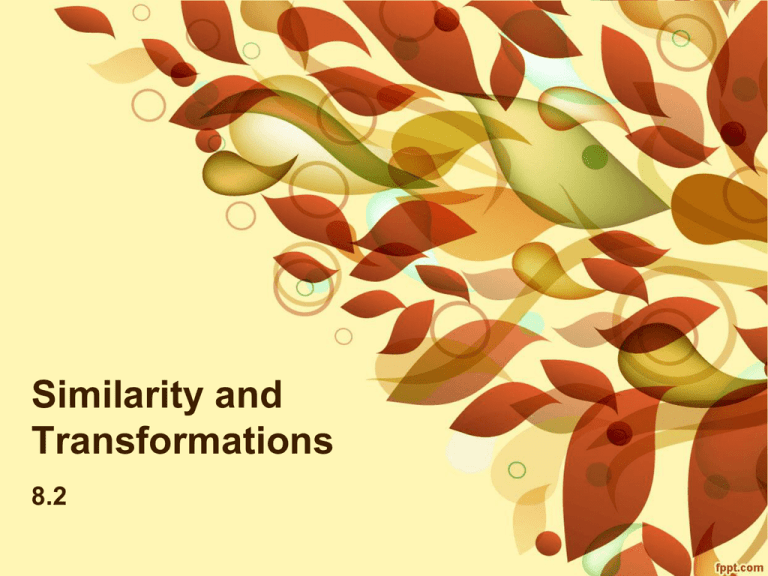
Similarity and Transformations 8.2 Warm Up Find the image point when the indicated transformation is applied to the given pre-image point. 1. (x, y) → (x + 3, y – 1); (2, 4) (5, 3) 2. (x, y) → (x, –y); (–2, 1) (-2,-1) 3. (x, y) → (3x, 3y); (–5, 0) (-15,-0) 4. (x, y) → 1 x, 1 y ; (3, -6) 3 3 (1,-2) Example 1: Drawing and Describing Dilations A. Apply the dilation D to the polygon with the given vertices. Describe the dilation. D: (x, y) → (3x, 3y) A(1, 1), B(3, 1), C(3, 2) dilation with center (0, 0) and scale factor 3 Example 1: Continued B. Apply the dilation D to the polygon with the given vertices. Describe the dilation. D: (x, y) → 3 x, 3 y 4 4 P(–8, 4), Q(–4, 8), R(4, 4) dilation with center (0, 0) and scale factor 3 4 Example 2 : Determining Whether Polygons are Similar Determine whether the polygons with the given vertices are similar. A. A(–6, -6), B(-6, 3), C(3, 3), D(3, -6) and H(-2, -2), J(-2, 1), K(1, 1), L(1, -2) Yes; ABCD maps to HJKL by a dilation: (x, y) → 1 x, 1 y 3 3 Example 2: Continued B. P(2, 0), Q(2, 4), R(4, 4), S(4, 0) and W(5, 0), X(5, 10), Y(8, 10), Z(8, 0). No; (x, y) → (2.5x, 2.5y) maps P to W, but not S to Z. Example 2: Continued C. A(1, 2), B(2, 2), C(1, 4) and D(4, -6), E(6, -6), F(4, -2) Yes; ABC maps to A’B’C’ by a translation: (x, y) → (x + 1, y - 5). Then A’B’C’ maps to DEF by a dilation: (x, y) → (2x, 2y). Example 2: Continued D. F(3, 3), G(3, 6), H(9, 3), J(9, –3) and S(–1, 1), T(–1, 2), U(–3, 1), V(–3, –1). Yes; FGHJ maps to F’G’H’J’ by a reflection : (x, y) → (-x, y). Then F’G’H’J’ maps to STUV by a dilation: (x, y) 1 x, 1 y 3 3 Example 3: Proving Circles Similar A. Circle A with center (0, 0) and radius 1 is similar to circle B with center (0, 6) and radius 3. Example 3: Continued Circle A can be mapped to circle A’ by a translation: (x, y) → (x, y + 6). Circle A’ and circle B both have center (0, 6). Then circle A’ can be mapped to circle B by a dilation with center (0, 6) and scale factor 3. So circle A and circle B are similar. B. Circle C with center (0, –3) and radius 2 is similar to circle D with center (5, 1) and radius 5. Example 3: Continued Circle C can be mapped to circle C’ by a translation: (x, y) → (x + 5, y + 4). Circle C’ and circle D both have center (5, 1).Then circle C’ can be mapped to circle D by a dilation with center (5, 1) and scale factor 2.5. So circle C and circle D are similar. Assignment • Pg. 256-257 3, 6, 12, 25, 26




